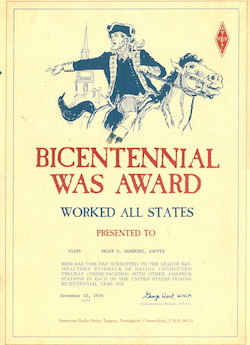
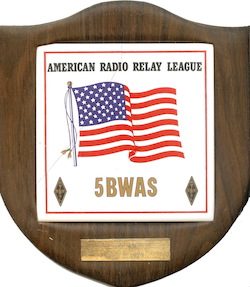
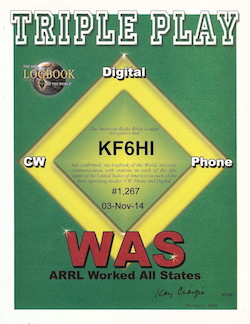
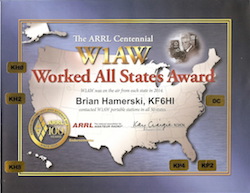
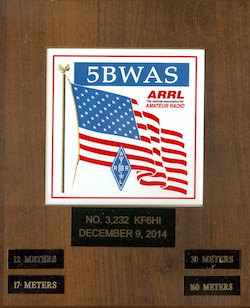
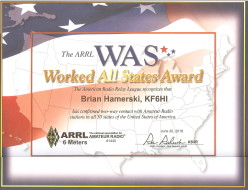



|

|
| I was living in Southeastern Minnesota and licensed as a Novice in June 1975 with callsign WN0PTB. I upgraded to General class as WB0PTB in May 1976. That year was the USA Bicentennial and the FCC allowed us to use AB instead of WB in our calls, so I operated as AB0PTB. This was back in the day without packet spotting, FT8, and the number of amateurs was smaller. Not to mention that we were at a Sunspot minimum just at the start of Cycle 21 rendering 10 and 15 meters almost useless. Worked All States was harder to achieve. I remember getting some help on the rare states from a 40 meter phone WAS net. The result was my first achievement award, WAS during 1976, the Bi-Centennial. | It was now 1977. I upgraded to Advanced class in May 1977. I was now hooked. In the process of the getting the basic WAS award, I took inventory and saw I had a good start on 5BWAS; that is WAS on the 10, 15, 20 40 and 80 meter frequency bands. WARC bands were not yet in existence at this time. There were two challenges to this. 1) We were still at a sunspot minimum. 2) I was graduating from High School in 1987 at which time I would be leaving home for College, ending my quest. I learned a lot trying to achieve my goal. Use of Sporadic E on 10 and 15 meters, use of backscatter on 10 and 15 meters, and long nights on 80 meters waiting for propagation to be favorable. In June 1978 I received 5BWAS from Minnesota. My equipment was a Tri-bander at 40 feet, with blockage to the South (see photo), and wire dipoles on 40 and 80 with apex at 35 feet. Power output was 100watts. |

|

|
| Timewarp now to 1989, now in California, and now in a Townhouse where I can put up dipoles in my attic. I upgrade to Extra class in 1990 and moved to a home in 1993. However my interests lay in DXCC and WAZ. The ARRL establishes the Triple Play award in 2009; WAS requiring Morse Code(CW), Phone AND Digital modes. I figure, sure, let's try. I don't remember when I started, but my award is dated 2014. | It's 2014 and the ARRL is celebrating their 100 year anniversary. Special event stations are on the air from each US state and USA territory in a round-robin fashion by month. Initially I saw no interest in this. But late Feb I worked a few stations and as usual got hooked. I got all 50 states with endorsements for each USA territory. |

|

|
| With all this WAS activity, you guessed it, hat about 5BWAS from California? and what about those other frequency bands. So I start again. And to make things more interesting in 2014 we decide to move to Arizona, so I have a deadline to complete. This was fun, all bands (160, 80, 40, 30, 20, 17, 15, 12, 10) completed December 2014. | We moved to Arizona fall of 2015. I'm not going to start 5BWAS over again, but, there are still more bands that I have not personally tackled. I have always loved 6 meters, frequency = 50MHz. I work with a 5 element homebrew antenna up 20 to 25 feet. Max power output 100 watts. I worked on this for a long time from California, but the hill to the east was killer for east coast. I moved to Arizona without hills and was able to achieve it in two years. Actually got the lower 48 states year one, HI and AK second year. Alaska and Hawaii are the toughest as they rely on 2-hop Sporadic E propagation. I have a whole page dedicated to 6-meters. Explore the propagation and see the contacts. 6M from AZ |

|

|
| What about 60 Meters? 60WAS #24. 60 meters is a fun band. The hardest states were ND and MT. I have only heard two MT stations, worked one. I have only heard one ND, and was lucky to be in the right place and right time to work him. Note, ARRL does not recognize 60M awards so this is from a separate entity 60metersonline.com/. | The future.... I have always wanted to get into EME, even wrote a moon tracking software program in high school....maybe 2m or 70cm EME WAS??? |
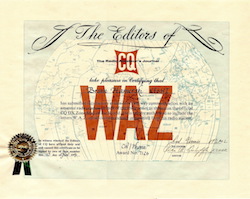
|
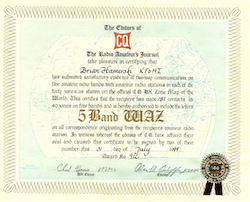
|
|
Basic WAZ 40/40 Zones 40 Zones, any band, any mode. I started working hard on this award after moving into my california two-story townhouse in 1989 with short linear loaded dipoles in the attic. Surprisingly I achieved WAZ with this setup and a max power of 500 watts. I did however benefit from the fact that this timeframe was on the upside of Sun Spot cycle 21 with Solar Flux never less than 150, many times over 200, with 10 meters being very productive. My last zone? zone 34 in 1991. Total of 2 years to work all 40. Link to list of QSOs/QSLs for the award. |
5BWAZ 199/200 Zones WAZ rules. The basic award is for 150 of the 200 possible zones. Endorsements are available in increments of 10 and a plaque is available for reaching 200. For those with disadvantaged antennas take note. With attic dipoles and 500 watts: 10M:40 zones, 15M:40 Zones, 20M:40 Zones, 40M:36 Zones, 80M:15 Zones, total of 171 Zones. As expected, 40 and 80 Meters were tough. Moving to a house with 3/4 acre lot in 1993 I was able to put up a GAP VoyagerDX antenna for 40 and 80. Granted a lot of work was done at the peak of Sun Spot Cycle 21. Less than a year with the antenna I had enough to apply with 181 zones. I now have 199 confirmed (writing this reminds me so send in for my endorsements!). THE ZONE LEFT: 34 on 80 Meters Anyone out there that can help? |

|
|
|
160M WAZ 35/40 Zones confirmed, 35/40 Zones worked Award #555 (paper is in the mail). The 160 Meter WAZ Award requires that the applicant submit QSL cards from at least 30 zones. Endorsement stickers are issued at the 36, 37, 38, 39, and 40 zone levels. The latest award list from CQ Magazine can be found here. In 2015 I moved to Arizona on a 1.3 acre lot. I put up a 55ft top loaded vertical with 30 on ground radials. We are now in a Sunspot minimum which keeps the Solar Wind Low and Flares at a minimum. All good for 160M. I surpised myself with being able to quality for this award. Zones I still need are 21,22,34,37,39 |
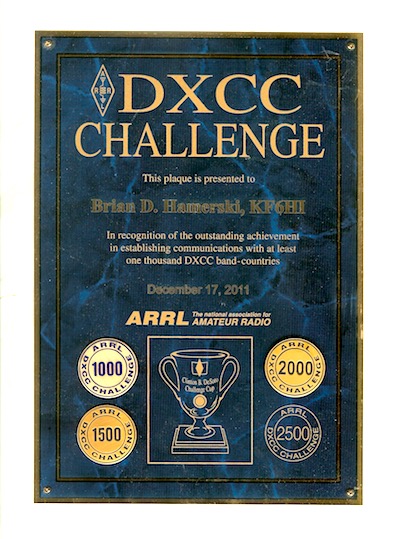
|
||
| DXCC Challenge Recognition of total confirmations with DXCC entities (current only, deletions do not count) on 160 through 6 meters (except 60 meters) for a total of 10 bands. Maximum is 10*340 = 3400. A very lofty accomplishment. The current list of awards given is here. 3264 is the maximum anyone has attained from those in Europe where DXCC entities are like States here in the USA. | ||

|
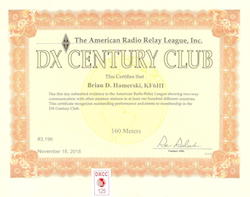
|
|
| Mixed DXCC. Any mode (Phone, CW, etc) on any frequency. Achieved initial 100 entities in 1990. Today, 28+ years I still don't have them all. 323 total CURRENT entities confirmed, missing 17. Overall I have 333 confirmed current and deleted. Endorsement at 335. | 160 Meter DXCC. Just above the USA AM broadcast band is 160 Meters at a frequency of 1.8 MHz. Europe, where most of the countries are, is very hard from USA west coast. Thought I would never achieve this one, but got #3196 Nov 18, 2018. Endorsement at 125. | |
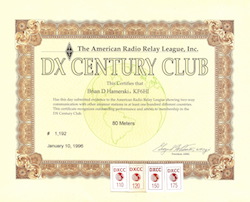
|
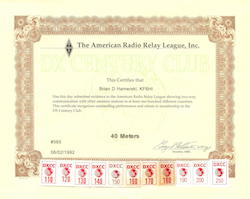
|
|
| 80 Meter DXCC. This band is tough. It requires a large antenna and is usually high with noise. I use a simple vertical. I tend to put a lot more time and antenna work on 160M, so my 80M operating suffers a little. Endorsement at 200. | 40 Meter DXCC. One of my favorite bands. It was the band I used for my first QSO back in 1975. One of the nightime bands. There is a wide variety of propagation phenomenons. Sunrise/Sunset enhancement. Long Path (going the long way around the world to make the contact). Long/short propagation. Endorsement at 250. | |
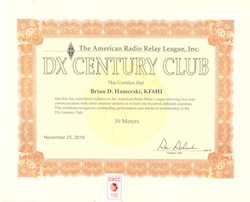
|
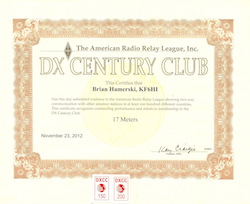
|
|
| 30 Meter DXCC. This is a new band WARC band opened in the early 1980s. Only CW and digital modes are allowed on this band. It is also limited to 200 watts. | 17 Meter DXCC. This is a new band WARC band opened in the early 1980s. At solar max it does not get a lot of use, but at solar minimum it is usually the best band for DX. Endorsement at 200. | |

|
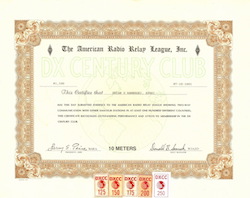
|
|
| 12 Meter DXCC. This is a new band WARC band opened in the early 1980s. This band has potential, however it is under underutilized. During low sunspots it rarely opens. During high sunspots everyone goes to 10 meters. Endorsement at 150. | 10 Meter DXCC. A very fun band. But rarely open. It opens every summer during the sporadic-E season. It has fantastic openings during the years of sunspot maximum. Literally you can work DX using a 10meter equipped HT. | |

|

|
|
| Digital DXCC. Back in the day, this was essential RTTY DXCC. Today we have many more digital modes, the most popular being FT8. My award is mostly RTTY. I do use FT8 to add new ones, but if at all possible if the station uses RTTY I try for that mode. Endorsement at 200. | CW, Phone DXCC. CW and Phones are the traditional modes for a DXer. I never applied for the certificates, but do tally my totals here. | |
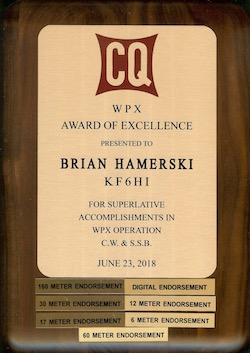
|
|
|
Award of Excellence The WPX Award of Excellence
requires a lot of contacts, and a lot of time to achieve. The requirements for the award are
ALL
of the
following: 1000 prefixes in Mixed mode 600 prefixes in SSB 600 prefixes in CW 600 prefixes in North America 95 prefixes in South America 160 prefixes in Europe 90 prefixes in Africa 75 prefixes in Asia 60 prefixes in Oceania 175 prefixes on 80 Meters 250 prefixes on 40 Meters 300 prefixes on 20 Meters 300 prefixes on 15 Meters 300 prefixes on 10 Meters Endorsements: 50 prefixes on 160 Meters 175 prefixes on 60 Meters (My endorsement was the second one issued) 250 prefixes on 30 Meters 300 prefixes on 17 Meters 300 prefixes on 12 Meters 250 prefixes on 6 Meters 300 prefixes on Digital My Current WPX Status is here | |
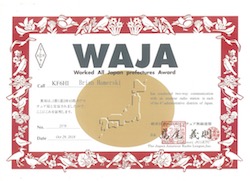
|

|
| WAJA Being on the West Coast of USA Japan is not that difficult to work. Pileups can be fun. When the Sun is active, 10 meters is a blast. In the early 90s I worked hard to work all 47 prefectures. I worked them all except for #47. I lost interest but kept working JAs. Now retired I looked over the log and QSLs and saw that I now had many prefecture 47 (Okinawa) stations worked. So I finally got the award. Nice award printed on glossy card stock. Link to list of QSOs/QSLs for the award. | JCC Currently tallying up my JCCs (Japan Cities), so far up to 292 confirmed....little more work to qualify for the 300 level. Including deleted entities there are a total of 800 Cities ! |
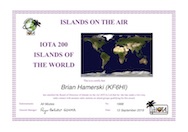
|
|
| IOTA My IOTAs...297 worked with 266 confirmed. This qualified me for IOTA-200. |
Copyright 2016-2021 - Brian Hamerski, KF6HI